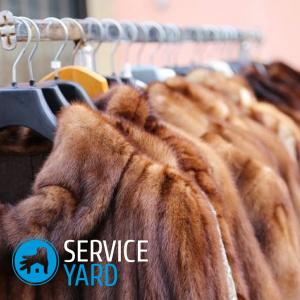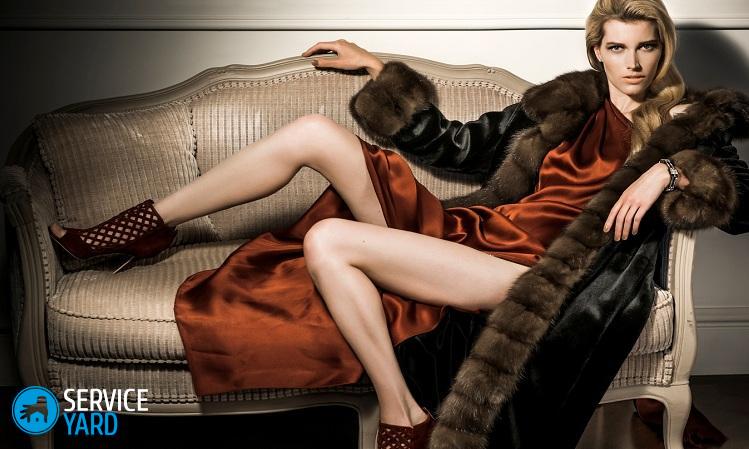How to make fur coats?

Almost every woman wants to have a natural fur product in her wardrobe, whether it be a fur coat or short fur coat - there is no difference. But few people think about how to make fur coats. The process of manufacturing products from natural fur takes a huge amount of time and many lives of innocent animals. Now in the windows of fashion stores you can see models from the fur of various animals. The cost of each fur product is different, as they differ from each other by the processing technique, types of animals and other details, which will be discussed later.
to contents ↑Types of fur
Some women still at least once visited the questions: how to make natural fur coats and from whose fur? The following types of furs are distinguished.
Nutria
In the manufacture of natural fur products using American or European breed of rodents. Their skin has a very beautiful, silky sheen. Often, the fur is nipped a bit, as a result of which soft downs are shown, which are very similar to beaver fur.
Sheepskin
The Persian astrakhan is very popular in the production of short fur coats. Despite the name of the breed, the animal hails from Kazakhstan. High-quality fur is obtained from newborn lambs of gray and black color.
Many are interested in the process of producing muton coats. They are made from formalin-treated sheepskin. Such products are perfect for severe frosts. They are moisture resistant and retain heat for a long period of time.

Fox
Their fur is considered one of the most beautiful and longest. Depending on the type of fox, there are various shades of skins. For example, the polar fox has white or bluish hair. An ordinary steppe fox has a reddish coat with a golden brown tint.
Sable
It is considered the most valuable and beautiful fur. These animals are quite difficult to breed, so their skin is so highly regarded. Fur is very soft and shiny. It has many shades of brown.
Mink
One of the most practical and wear types of fur. Male minks are much larger in size. Their fur is longer, and the skin is thicker and rougher than that of females, so they are often used for slaughter.
Important! The most popular and beautiful of mink furs is the Scandinavian black mink.
Arctic fox
The fur of this animal is very soft, thick and long. Often his fur is used to make hats. Hunters most often hunt for white foxes, and blue bred in fur farms.
Important! A hat made from the skin of this animal can last at least 12 seasons.
Each of the above types of fur is in great demand and is of high quality and reliability.
to contents ↑What is necessary to obtain high-quality fur?
For fur farmers involved in fur farming, getting high-quality skins is hellish work. All processes are planned up to a second, because the animals need constant care and good conditions for development and reproduction. Consider several factors that affect the quality of fur:
- Temperature is one of the most important factors, as some species of animals (minks, Arctic foxes) may not tolerate extreme heat or cold. At fur farms, workers set the temperature acceptable for the animals to have a good life.
- Maintaining cleanliness - this reduces the risk of disease in animals.
- Nutrition is a very important detail in the development of each animal. For example, when minks are still very small, they are given oily fish (blue whiting), and in their “teens” they are fed trout, salmon and meat. And during lactation, animals add protein products to the diet - cottage cheese, an egg. Many other animals are fed on the same principle.
Important! Vitamins and minerals contained in food have a huge impact on the quality of the coat.
- Vaccination is a necessary measure to prevent the development of diseases in animals. Usually it is carried out when the animals are still small.
These factors play a huge role in the development of the “fur business”. That is why luxurious fur coats made of natural furs cost such a lot of money.
to contents ↑Skins Processing Technological Processes
In order to get a beautiful fur coat, killing an innocent animal will not be enough. This begs the question of how fur coats are made from animals? After the required number of animals was slaughtered, the processes of processing their skins begin. Let's consider them in more detail:
- Coating The procedure received its name from the word "mezdra" - subcutaneous fat. This process involves removing a layer of subcutaneous fat. As a result, the skin becomes thinner. Remove fat with the help of special substances and devices. First, the skin is soaked and fat is removed, and then treated with tannins. After that, again subjected to cleaning and processing.
- Depilation - excess hair is removed. As a result, the skin becomes more elastic. The skins of long-haired animals (fox, raccoon) are sheared.
- Toning and discoloration - the procedure is necessary to remove defects in the color of the coat. It is either discolored to be painted in a different color, or tinted in necessary places.
Without these processes, you will not be able to ultimately get a chic natural product.
to contents ↑How is a mink coat made?
Minks are considered very malleable, but very whimsical animals, despite the fact that they are easy to breed. Products from their fur look luxurious and rich. In addition, at a cost they are much cheaper than other copies of natural skins.
Consider the process of manufacturing mink products in brief:
- Mink skins are selected according to the color and length of the coat. Cut even stripes of skins and number them in the order in which they will be stitched.
- After stitching the skins, they outline the patterns and begin to correct the cut along the contour using a pneumatic gun. All visible seams are dyed in the tone of the coat and the skins are dried. After drying, the pattern is transferred to the future product.
- In accordance with the pattern, pieces are cut out from which the product will be sewn.
- After preparing all the elements, proceed to the assembly of the future coat. Using a special sewing machine, all the elements are sewn together. And then the product is subjected to chemical processing.
- Using a steam generator, the product is laid and ironed. After that, the lining and other small details (buttons, loops, hooks) are sewn.
Stock footage
From all of the above, we can conclude that the production process of natural fur products is not easy. However, as a result of the work done, a chic, high-quality fur coat is obtained. And is it worth the life of the animals to show off in their skin or not - it's up to you to decide.
- How to choose a vacuum cleaner taking into account the characteristics of the house and coatings?
- What to look for when choosing a water delivery
- How to quickly create comfort at home - tips for housewives
- How to choose the perfect TV - useful tips
- What to look for when choosing blinds
- What should be running shoes?
- What useful things can you buy in a hardware store
- Iphone 11 pro max review
- Than iPhone is better than Android smartphones



